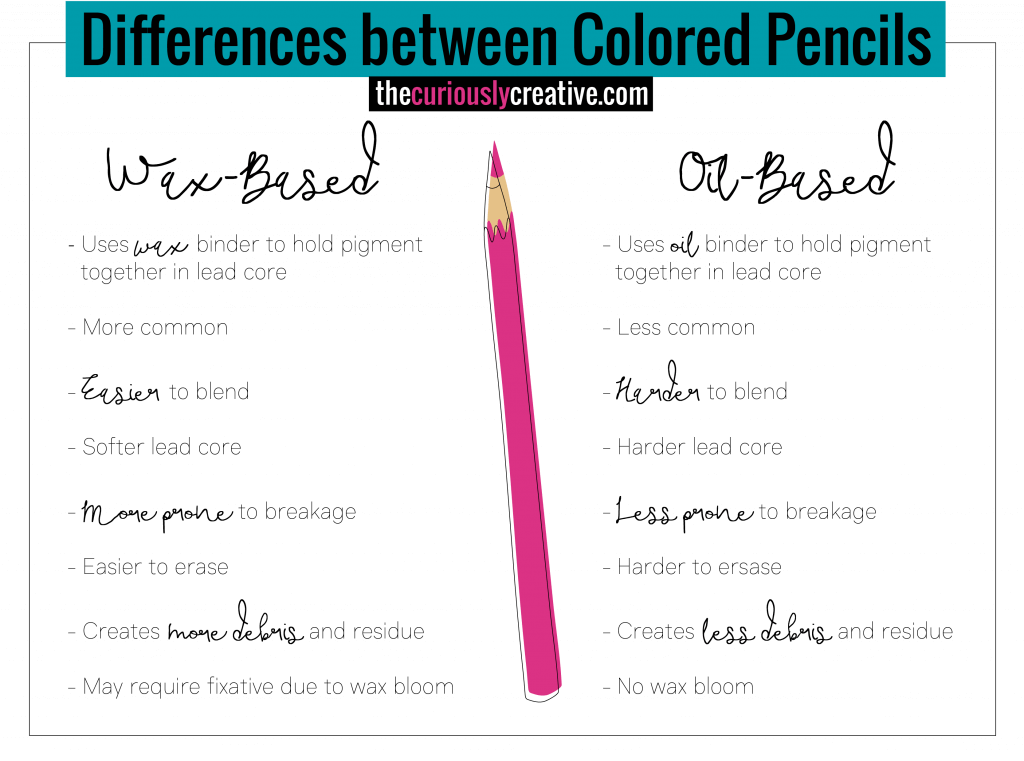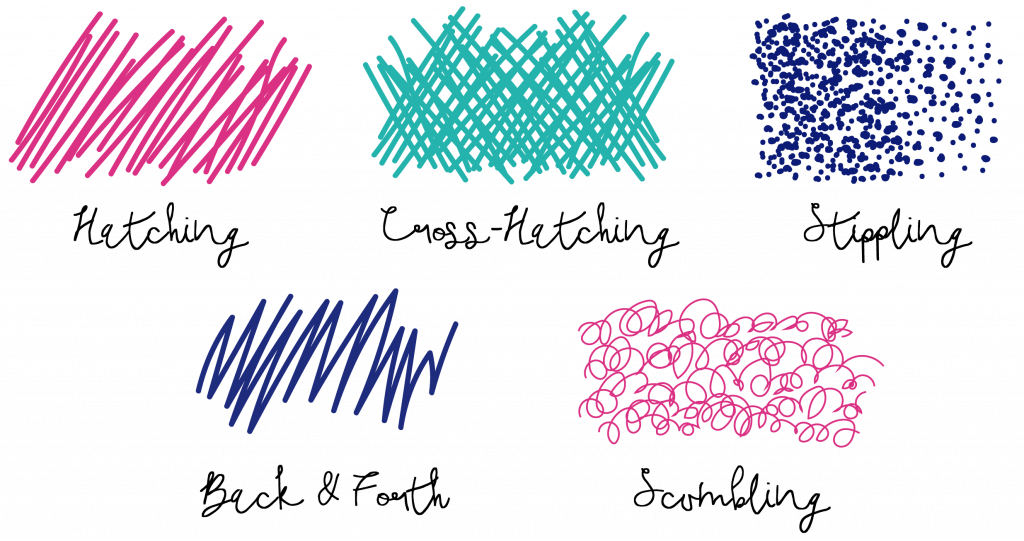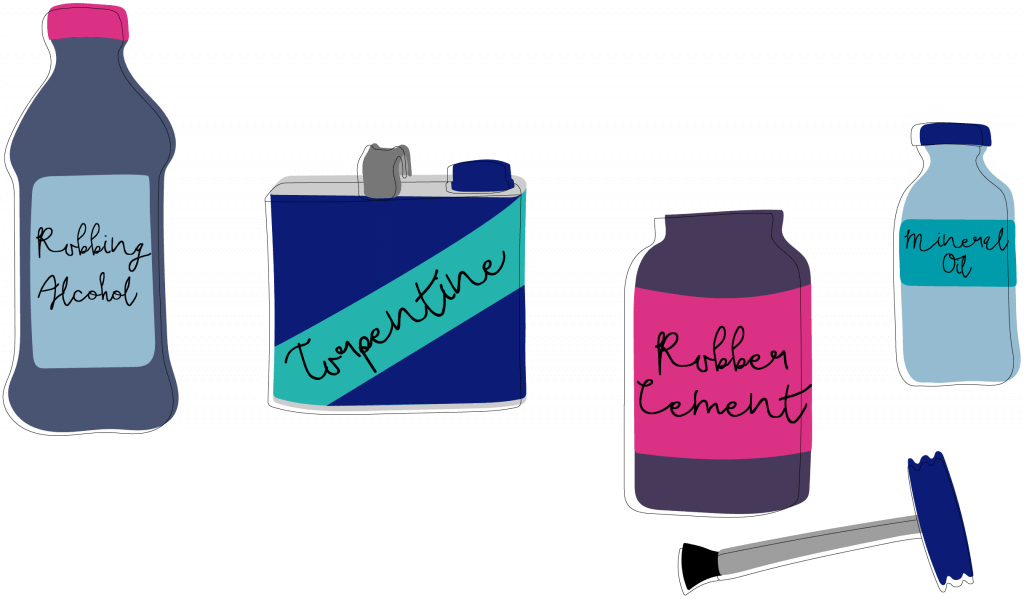So you want to get into colored pencils? Well, this beginner’s guide is a great place to start! Colored pencils are a great art medium to explore. You’ve probably drawn with them as a kid but now is the time to really learn about them to see what sort of amazing art you can create.
Here’s a list of what’s covered in this guide so you can easily jump to each section.
Completely new to drawing?
Check out my beginner’s guide to drawing to learn the basics of drawing in just 4 weeks and covers basic pencil holding techniques, coloring, 2D and 3D shapes, perspective, figure drawing, and much more.
This colored pencil guide will use some terms assuming a basic knowledge about drawing.
Introduction
Before becoming an art medium, colored pencils were used for checking and marking.
Although it is unclear exactly when they were created, it wasn’t until the early 20th century that artist-grade colored pencils were manufactured.
Thank goodness for that because colored pencil art can be absolutely PHENOMENAL.
A colored pencil is a narrow, pigmented core generally contained within a cylindrical, wooden case (usually cedar).
However, there are colored pencils that exist without wood encasings as well.
Colored pencils is an art medium that is similar to graphite pencils except in the fact that it allows for the art to be created with a colored pigment.
Although there are several different brands, not all colored pencils are created equally. Even within each brand, there are a variety of factors to consider when choosing colored pencils.

The 3 Different Types of Colored Pencils
Colored pencils vary in the type of binder within the pigmented core. The binder holds the pigment together and can determine the hardness or softness of the lead.
High-quality colored pencils will have a higher ratio of pigment to its binder.
The core can be either wax-based, oil-based or gum arabic-based depending on the binder used within the pigment. Gum arabic-based colored pencils are generally referred to as water-soluble or watercolor pencils.
Factors to consider while selecting colored pencils can include the softness or hardness of the lead, blending potential, erasing potential, strength of the core, color availability, and price.
#1 Wax-Based Colored Pencils
Wax-based colored pencils use a wax binder to hold together the pigment within the colored pencil’s core. Remember your Crayola or RoseArt or off-brand colored pencils you used in elementary school? These were wax-based.
Not only are they pretty common for the general population, but wax-based colored pencils are also popular for artists as well.
However, you may be more familiar with a hard lead wax-based colored pencil. Artists and professionals typically use higher-quality colored pencils with a softer lead (higher ratio of pigment to binder).
Wax-based colored pencils are much easier to blend than oil-based colored pencils. They’re also easier to layer since they lay down much less color to start.
Wax-based colored pencils also blend well with colorless blenders, heat or solvents–even better when using ones with softer lead cores. Because these have softer cores than oil-based, they are unfortunately more prone to breakage.
Since they lay down less color, wax-based colored pencils are also easier to lift pigment off the paper when you want to erase. These pencils also create more debris than oil ones.
Just make sure you brush frequently throughout the drawing process You don’t want to contaminate your artwork. The residue from one color can interfere when you are trying to lay down another color.
Artwork using wax-based colored pencils may also require a fixative on your final product.
These colored pencils can sometimes create a white, hazy glaze over your artwork, also known as wax bloom.
Wax bloom is caused by the pigment settling down on the surface and the wax binder rising through. Lower quality wax-based colored pencils are more prone to this effect.
To remove wax bloom, you can use a soft cloth to wipe it away. If you’d like to prevent it altogether, a fixative should help.
However, fixatives can sometimes change the color of your artwork so be cautious when deciding to apply it.
#2 Oil-Based Colored Pencils
Oil-based colored pencils use a vegetable-based oil binder to hold together the pigment within the colored pencil’s core. Oil-based colored pencils may still have wax within their core but contain a much higher oil content in comparison.
These colored pencils tend to have a harder lead core than wax which leads to less breakage. As expected, oil-based colored pencils are resistant to water.
As mentioned above, oil-based colored pencils do not blend as easily and can be harder to layer than wax-based. However, they create much less debris while drawing and will not display signs of wax bloom.
Oil-based colored pencils can be more difficult to find in regular stores but definitely sold at art supply stores. They are also higher in price than wax-based colored pencils.
#3 Watercolor Pencils
Watercolor pencils, or water-soluble pencils, have a gum arabic binder for their pigmented core.
The Arabic gum binder can be activated by water which allows the pigment to blend with water, much like watercolors.
Since its techniques vary more than the other two, this is as much as we’ll cover this topic for now as watercolor pencils deserve their own separate (future) guide.

Which Brand and Type of Colored Pencils Should I Buy?
Each type of colored pencil has its pros and cons. They can also be mixed when creating artwork.
If you are used to using wax-based colored pencils, you may want to explore other types to see how they work for you. I also suggest that you test out different types of colored pencils to determine what works best for your style of drawing.
As a beginner, you may want to start out with student-grade colored pencils just so that you get a feel for the art medium.
You can start to invest in professional-grade once you dive deeper into this skill.
If budget is not an issue for you, professional-grade art supplies will give you a better idea of what it’s like to work with the medium.
The Virtual Instructor has a great comparison chart that focuses on price, type, and general pros and cons. About.com also has a nice article on several popular brands.
Storage
Throw out the original box! I wouldn’t recommend storing it in the original packaging since you’ll be going back and forth trying to slip the pencil in the correct slot.
This can increase the risk of damaging the lead or tip of the pencil and lead to frequent breakage.
Instead, try separating your colored pencils by color (cool colors, warm colors, reds, grays, etc.) and use a rubber band to fasten them. Make sure that you be cautious of the lead tips in whatever container you ultimately use and generally try to avoid dropping them.
Alternatively, store them upright to minimize breaking the tips of your pencils. This bamboo rotating organizer has 7 spaces to store your art supplies!

Paper
When selecting paper for colored pencil art, you want to select one that at least has some tooth to it.
This will help the colored pencil pigment grip on to the surface. If you select paper that is too smooth, it may be difficult to properly layer your colors.
If you select paper that is too rough, it might be difficult to portray details and
Stonehenge paper is a great option because it is 100% cotton and has great tooth.
It is also pretty affordable and comes in a variety of colors and sizes.
Bristol paper with a vellum surface is also a worthy option. Illustration boards are also a good option for colored pencils because it is strong and can withhold the pressures of burnishing or solvent blending.
There are tons of paper selections for colored pencils and experimenting with different kinds will help you find the best option for yourself.
How To Sharpen Your Colored Pencils?
Make sure you sharpen your colored pencils as soon as you open your new box! Keeping your colored pencils sharpened is extremely important.
Sharp lead points penetrate color into the tooth of the paper much more easily than a dull point.
A dull lead point won’t be able to deliver color effectively into the tooth’s pockets.
Naturally, you may apply more pressure once you see that the pigment isn’t depositing onto the paper.
However, this can result in excessive color on the paper sooner than intended, and will be difficult to control the desired color when layering.
There’s a variety of options you can use to sharpen your colored pencils including handheld pencil sharpeners, electric pencil sharpeners, cosmetic sharpeners, and a few others.
If you purchase professional-grade colored pencils, try to use higher-quality sharpeners. Higher-quality sharpeners tend to have sharper blades that will minimize the breakage of the tips.

Handheld Pencil Sharpeners
Handheld pencil sharpeners are generally small and in my opinion, the best at sharpening colored pencils.
Sharpening your pencil using this method allows you to control the force and speed at which you sharpen.
Try finding a sharpener with a larger opening to keep more of a wood encasing to create a less pointy color core while sharpening.
You can still have a sharp pencil but more wood covering the color core will reduce the risk of breakage.
Hold the pencil vertically and turn the sharpener rather than the pencil to sharpen.
This will prevent you from applying excessive pressure and minimize breakage. Make sure the blade on the sharpener remains sharp. You’ll be able to tell this based on the length of the pencil shaving.
If your pencil shavings come out in short, broken segments, either replace the blade or it’s time to buy a new one.
Here’s a pack of 4 affordable handheld sharpeners but if you want to splurge, get this Prismacolor pencil sharpener.
I don’t really like to spend money so I will go as long as I can using the most affordable options. However, I received this Prismacolor pencil sharpener as a gift one year and I absolutely love it!
Electric Pencil Sharpeners
Electric pencil sharpeners apply a force that is more difficult to control. The wax from your colored pencil can build up between the blades inside your sharpener.
To avoid this, you can sharpen regular graphite pencils on a regular basis to help “clean” the blades. If you choose to use an electric sharpener, avoid ones with straight blades as it can break the lead.
Cosmetic Sharpeners
Cosmetic sharpeners are specially made to handle pencils with a softer core like eyeliner.
Because of this, its design can also sharpen colored pencils without producing too harsh of a sharpen.
Other Ways To Sharpen Your Pencils
Sandpaper blocks can also be used as a sharpener by running the colored pencil across the surface of the sandpaper, rotating the pencil to ensure you produce an even sharpen.
You can also go old-school and use a knife to sharpen your colored pencil.
A hand-crank pencil sharpener, like the ones you might remember from elementary school, are a bad choice.
The blades are less than ideal and it will completely destroy your colored pencils.
Coloring Techniques
Pencil Techniques
A variety of techniques exists for drawing and coloring with colored pencils. These techniques can provide different results in terms of the coverage of pigment on your surface.
Coloring techniques include stippling, hatching, cross-hatching, back and forth strokes, or scumbling. You can even create your own techniques.
When drawing, you also want to follow the contours and texture of the object to create more realistic portrayals.
Check out a quick guide from HowToDraw.com or watch a video from The Virtual Instructor to learn these different techniques.

Applying Color
You want to work from light to dark hues since light colors aren’t as apparent on dark colors.
It’s much more difficult to fix darker colors than lighter colors. You also want to be aware of the pressure when applying color.
The stronger the pressure, the more intense the color will be. Because of this, you may want to start off with light pressure to avoid applying dark colors too quickly.
Highlights
For this reason, you also want to outline any highlights on the artwork before coloring so that you can avoid accidentally applying darker colors in this area.
Depending on the paper you are using, you can also omit to apply colors on highlights and utilize the color of the paper instead.
For example, leave certain areas open on white paper to portray the specular highlights on a shiny object.
You can also create highlights by using a white colored pencil, crayon, pastel, acrylic paint, or gouache.
Shading
When shading, you should avoid using black and select a darker hue of the color instead.
Using black can deliver too strong of a hue and make the colors of your artwork look a little off if you are going for a more realistic portrayal.
When coloring, it is also recommended that you complete smaller areas rather than working on the entirety of the artwork at once. Doing so will significantly reduce smudging!
Blending Techniques
If you have a limited amount of colors, you want to create a color mixing chart. A color mixing chart will help you see what colors you can create with the pencils you currently have.
It’s a great tool that may take a bit of time to create in the beginning but will prevent mistakes and any trial-and-error blending you would probably be doing without it.
When blending, it’s very important that you understand color. Blending will work best if you select colors that are closer to each other on the color wheel or in the same color range.
When you use contrasting colors, you’ll need to ensure that the colors aren’t within the same color range to improve visibility and contrast.
Blending colored pencil artwork can be a bit different from graphite work. You can’t use a blending stump or tortillion. Instead, you can utilize pencil blending, solvent blending, or even dry blending.
Pencil Blending (Burnishing)
Burnishing is the act of using pressure to combine the layers and completely fill the tooth of the paper with color.
This will result in a very smooth and shiny appearance of color on your artwork.
You want to use a sharp colored pencil for this since this will help saturate the paper more quickly with color.
Colorless Blenders
Colorless blenders are pigment-less wax-based colored pencils that can be typically found at your local art store.
These can be used to blend and soften the edges of your artwork but is not as effective as using solvent blenders.
Solvent Blending
Solvents will disrupt the binding of colored pencils to allow for a blending of colors.
This will help decrease the appearance of coloring strokes and allow for a smoother appearance. There are a couple of different types of solvents you can use with colored pencils.
Regardless of what solvent you use, make sure to test it on the paper first to see it can hold up against the paper.
You also want to make sure you wait for the solvent to completely dry before applying color again.
To help aid the drying process, be prepared to wipe off excess solvents with a paper towel or cloth nearby.

Rubbing Alcohol
Rubbing alcohol can be used as a blender because it will disband the wax binder and move the pigment around the paper.
When using this solvent, try to select rubbing alcohol that is less than 70% of isopropyl alcohol.
Using a stronger one might start to remove the colored pencil pigment altogether. When applying the rubbing alcohol, use cotton balls or swabs to lightly apply a small amount at a time.
Turpentine
Turpentine is made from the resin of pine trees. It can be more effective than rubbing alcohol because it can disrupt more of the wax binder.
You may need to use stronger paper if you decide to use this solvent.
Turpentine can be applied a few times between each blend using bristles or soft brushes and moderate pressure (more so than the rubbing alcohol). Using turpentine can also help achieve a watercolor effect if desired.
Rubber Cement Thinner
Rubber cement thinner is an adhesive mixed generally mixed with latex and another solvent (like acetone) used to thin rubber cement.
This works very similarly to turpentine but is more effective in breaking up the wax binder.
You also want to use brushes with moderate pressure when applying this solvent.
Mineral Oil & Mineral Spirits
Both mineral oil and mineral spirits are petrolatum distillates but very different from one another.
Mineral oil is food-safe and can be used as a laxative, lubricant, or moisturizer. Mineral spirit is a type of thinner for finishes and definitely not food-safe.
It’s a very popular solvent in the paint industry. Odorless mineral spirits (OMS) lack harmful chemicals and can also be used for blending. Use brushes to apply lightly and have a paper towel nearby for excess solvent.
Dry Blending
Dry blending utilizes tools that don’t involve your pencil or a solvent such as paper towels, tissues, or blending stumps or tortillions.
These won’t be as effective as the blenders mentioned above but they will still blend the colors to a certain extent.
These items can also be used rather than brushes when blending with solvents.
Erasing
Colored pencils can be much more difficult to erase than graphite artwork but it is still possible.
Instead of erasing, you’ll have to use the method of blotting and lifting color off of the paper to eliminate mistakes. The heavier the layer, the more difficult it will be to lift the color off the paper.
This is why you should begin by lightly applying color until you become more experienced with this art medium.
White vinyl erasers and scotch tape work best to lift color off of the paper. I have been using this pack of 10 Pentel white vinyl erasers and it has lasted me for quite a while now.
Kneaded erasers will not fully erase but it can help lighten colors on your artwork. The quality of cheap kneaded erasers can vary so sometimes it’s best to pay a few bucks more for nicer ones like this set of 4 Faber-Castell kneaded erasers.
You can always try cheaper ones first. However, I’ve once purchased an art set that had a kneaded eraser that practically crumbled when I used it! It didn’t give me the full experience of a kneaded eraser and its true capabilities at all.
Regardless of the type of eraser you use, test it first on a separate piece of paper so that you are aware of the effect it might have on your artwork.
As previously mentioned, it’s recommended that you complete smaller areas rather than working on the entirety of the artwork at once.
Doing so will significantly reduce smudging and any erasing you might have to do.
Brushing
Colored pencils can leave residue on your artwork (wax-based more so than oil-based).
The debris can interfere with your artwork by becoming lodged in the tooth of the paper and contaminating the color.
To avoid this, you want to keep your artwork clean throughout the entirety of the creation process.
Use either a can of compressed air, small dusters, or cosmetic brushes periodically to keep wax or eraser debris off the paper.
Online Courses
Taking online classes can be helpful for beginners! Online courses can help you learn from experts in the field from the comfort of your own home.
- Colored Pencil Workshop: A Daily Practice (CreativeBug)
- Colored Pencil Pet Portraits (CreativeBug)
- Drawing with Colored Pencils: Basic Blending and Techniques (Skillshare)
- How to Draw Realistic Hair with Colored Pencils (Skillshare)
- Introduction to Watercolor Colored Pencils (Skillshare)
The classes listed below are offered through Domestika, a website with the largest community of creative professionals. Domestika originated from Spain but now headquartered in San Francisco.
The classes listed below are in Spanish with English subtitles. However, the classes are one of the highest quality content out there.
You can learn at your own pace alongside other students who have enrolled in the class too! Each class is pretty affordable and you have lifetime access!
Domestika has a growing number of courses offered in English too! Check them out here in my post, 15 Creative Courses on Domestika in English.
Colored Pencils Tutorials
Check out these great video tutorials to help you learn more about using colored pencils!
Need inspiration? Check out 12 amazing colored pencil artists you can follow on Instagram!
Overall Tips
- Research each brand before purchasing. Explore different types before settling on one!
- Throw out the original box and fasten with rubber bands separated by colors.
- Be careful of lead breakage and avoid dropping your colored pencils.
- Select a paper that has a bit of tooth to it to help the pigment grip the surface.
- Keep your colored pencils sharpened! Sharp points help deposit color into the tooth of the paper.
- Use handheld sharpeners to control the force and speed to minimize the risk of breakage.
- Sharpeners with a larger opening will keep more wood encasing and protect the color core.
- Work from light to dark hues to avoid the mistake of laying too much color too early.
- Outline highlights before coloring to avoid accidental applications of dark colors to this area.
- Avoid shading with black and use darker hues of the same color instead.
- Complete smaller areas instead of the entire piece at once to reduce risks of smudging!
- Create a color mixing chart if you have limited colors to see how your colored pencils blend.
- Blend artwork by burnishing or utilizing solvents like alcohol, turpentine, or mineral oil.
- Erase pigment by lifting color off of the surface of the paper using tape or an eraser.
- Periodically brush your artwork to prevent residue from contaminating the paper.
- Last but not least, practice!
RELATED CONTENT:
12 Amazing Colored Pencil Artists You Should Follow on Instagram
The Complete Beginner’s Guide to Drawing
The Quick Beginner’s Guide to Drawing Supplies
Week 1: The Beginner’s Guide to Drawing Basics: Part 1
Week 2: The Beginner’s Guide to Drawing Basics: Part 2
Week 3: The Beginner’s Guide to Perspective Drawing
Week 4: The Beginner’s Guide to Figure Drawing





